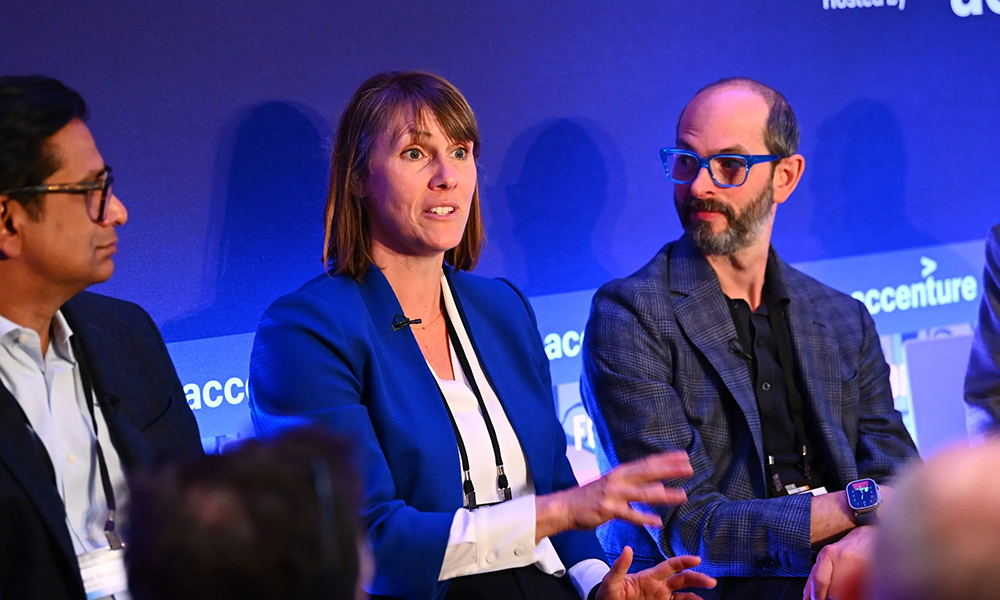
人工智能,尤其是生成式人工智能,只要得到实际应用,就能成为提高办公效率的强大工具。
问题在于上班族们过于恐惧,担心使用ChatGPT等工具自动完成越来越多他们的工作,将对他们构成威胁,而不是一种他们愿意参与的改变。
因此,人力资源咨询公司The Red Plate的总经理苏西·列维认为,秘诀在于如何让员工以“结构化和有趣味的方式”参与应用人工智能。通过这种方式,员工不再将人工智能视为不会给他们带来个人收益的工具,也不会将它视为应该害怕的对象。
在近日于伦敦召开的《财富》人工智能头脑风暴大会上,她向与会者表示:“公司内的每一个职能部门都应该有一个人工智能趣味化团队。”
列维分享了一个例子,一位熟人在鼓励下尝试使用ChatGPT写了不少于17份绩效评估。
下属只需要按照她的指示完成工作;其他工作由人工智能生成。这种分工让她可以专注于更有价值的任务,而不是去撰写必要但耗时的文本。
她说道:“通过完整的参与之旅,人们开始与这些工具互动,并思考如何利用这些工具改进自己的工作。毕竟人类善于发现他们的工作有哪些问题。”
劳埃德银行集团(Lloyds Banking Group)首席数据与分析官拉尼尔·波特儒相信,随着团队熟悉人工智能的功能,他们很快就会意识到它的好处。
例如,事实证明,与区块链等分布式分类账技术不同,人工智能在他的团队成员中很受欢迎,区块链技术仍在寻找一种有吸引力的应用。他的团队成员会向他申请使用人工智能,而不是拒绝使用。
波特儒表示,事实证明,对于高度重复和需要大量人工操作的低风险任务,人工智能有很大的帮助,而在银行业有大量此类任务。即使将验证和质量保证等问题考虑在内,人工智能依旧能带来足够的生产力提升,使得为此付出的努力在本质上都是值得的。
不要忽视犯罪问题
他提到的一个例子是,经常需要对传统IT软件系统进行全面检修,这项工作通常要交给团队内更有经验的软件开发者和数据工程师来完成。
波特儒表示:“他们要查看旧代码,然后从头开始重新编写,这需要漫长的时间。”而在他们开发的一款人工智能工具的帮助下,团队重新编写代码的效率提高了35%至40%。他补充道:“我确信未来几年,[银行业]会有足够多极低风险的机会。”
但人工智能也有一些缺点:人工智能可能助长盗窃行为,例如直接处理账户中的资金,甚至伪造他人的声音欺骗身份验证系统等。
不良分子肯定会利用列维的“人工智能趣味性”理念,测试他们如何用这项技术达到自己的目的。
因此,作为埃森哲(Accenture)的前领导力、多元化和员工参与负责人,列维认为每家组织在规划和准备过程中都需要将这种情况考虑在内。
她说道:“人工智能让这种不良行为变得更容易。我们必须考虑到人工智能被用于犯罪的可能性。”(财富中文网)
翻译:刘进龙
审校:汪皓
人工智能,尤其是生成式人工智能,只要得到实际应用,就能成为提高办公效率的强大工具。
问题在于上班族们过于恐惧,担心使用ChatGPT等工具自动完成越来越多他们的工作,将对他们构成威胁,而不是一种他们愿意参与的改变。
因此,人力资源咨询公司The Red Plate的总经理苏西·列维认为,秘诀在于如何让员工以“结构化和有趣味的方式”参与应用人工智能。通过这种方式,员工不再将人工智能视为不会给他们带来个人收益的工具,也不会将它视为应该害怕的对象。
在近日于伦敦召开的《财富》人工智能头脑风暴大会上,她向与会者表示:“公司内的每一个职能部门都应该有一个人工智能趣味化团队。”
列维分享了一个例子,一位熟人在鼓励下尝试使用ChatGPT写了不少于17份绩效评估。
下属只需要按照她的指示完成工作;其他工作由人工智能生成。这种分工让她可以专注于更有价值的任务,而不是去撰写必要但耗时的文本。
她说道:“通过完整的参与之旅,人们开始与这些工具互动,并思考如何利用这些工具改进自己的工作。毕竟人类善于发现他们的工作有哪些问题。”
劳埃德银行集团(Lloyds Banking Group)首席数据与分析官拉尼尔·波特儒相信,随着团队熟悉人工智能的功能,他们很快就会意识到它的好处。
例如,事实证明,与区块链等分布式分类账技术不同,人工智能在他的团队成员中很受欢迎,区块链技术仍在寻找一种有吸引力的应用。他的团队成员会向他申请使用人工智能,而不是拒绝使用。
波特儒表示,事实证明,对于高度重复和需要大量人工操作的低风险任务,人工智能有很大的帮助,而在银行业有大量此类任务。即使将验证和质量保证等问题考虑在内,人工智能依旧能带来足够的生产力提升,使得为此付出的努力在本质上都是值得的。
不要忽视犯罪问题
他提到的一个例子是,经常需要对传统IT软件系统进行全面检修,这项工作通常要交给团队内更有经验的软件开发者和数据工程师来完成。
波特儒表示:“他们要查看旧代码,然后从头开始重新编写,这需要漫长的时间。”而在他们开发的一款人工智能工具的帮助下,团队重新编写代码的效率提高了35%至40%。他补充道:“我确信未来几年,[银行业]会有足够多极低风险的机会。”
但人工智能也有一些缺点:人工智能可能助长盗窃行为,例如直接处理账户中的资金,甚至伪造他人的声音欺骗身份验证系统等。
不良分子肯定会利用列维的“人工智能趣味性”理念,测试他们如何用这项技术达到自己的目的。
因此,作为埃森哲(Accenture)的前领导力、多元化和员工参与负责人,列维认为每家组织在规划和准备过程中都需要将这种情况考虑在内。
她说道:“人工智能让这种不良行为变得更容易。我们必须考虑到人工智能被用于犯罪的可能性。”(财富中文网)
翻译:刘进龙
审校:汪皓
Artificial intelligence—and generative AI, in particular—can be powerful instruments to boost office productivity, so long as people actually use them.
The problem is there’s been so much fear mongering that workers feel the use of tools like ChatGPT to automate more and more of their job is a danger visited upon them, rather than a change they want to participate in.
That’s why Suzy Levy, managing director of human resources consultancy The Red Plate, believes the secret is figuring out how to engage workforces in a “structured and playful way.” With this approach, employees don’t see AI as a tool that offers no personal benefit to them—or as something they should outright fear.
“Every single function in an organization needs to have an AI playfulness team,” she told participants at the Fortune Brainstorm AI conference in London this week.
Levy recalled an instance where an acquaintance had written no fewer than 17 performance reviews with the help of ChatGPT after being encouraged to experiment with it.
What her subordinates needed to work on came from her own prompts; the rest came from AI. This division of labor allowed her to devote attention to tasks more valuable than crafting the requisite but time-consuming text around them.
“There is an entire engagement journey to get people to start interacting with these tools and thinking about how they can make their job better,” she said. “Because humans are experts at knowing where their jobs are terrible.”
Ranil Boteju, chief data and analytics officer at Lloyds Banking Group, was confident teams would soon realize the benefits of AI once they became familiar with its abilities.
Unlike, for example, distributed ledgers like the blockchain—technologies in search of a compelling application—AI was proving popular among his team members. They would come to him with a request to use AI rather than vice versa.
In particular, it was proving enormously helpful with very low-risk tasks that are highly repetitive and highly manual—something of which there is plenty in banking, according to Boteju. Even when validation and quality assurance is factored in, there are still enough productivity gains to make it intrinsically worth the effort.
Don’t forget the criminal element
One example he cited was the frequent job of overhauling legacy IT software systems that often fell to even the more experienced software developers and data engineers on his team.
“They would have to look at the old code and rewrite it from scratch, and that would just take forever,” Boteju said. Once they developed an AI tool to help, the team experienced a 35% to 40% efficiency improvement in their code rewriting. “I’m quite confident for the next few years there are enough very low-risk opportunities [in banking],” he added.
There are pitfalls, though: AI can facilitate theft, whether it’s directly handling money in an account or even a person’s voice in order to circumvent authentication safeguards.
Bad actors will certainly embrace Levy’s concept of “AI playfulness” to test out just how far they can use the technology to accomplish their goals.
A former head of leadership, diversity, and employee engagement at Accenture, Levy argued every organization will therefore need to factor this into their planning and preparation.
“AI makes doing dodgy things easier,” she said. “We have to insert an element of criminality in our thinking.”






